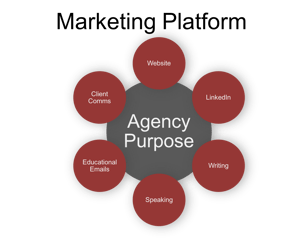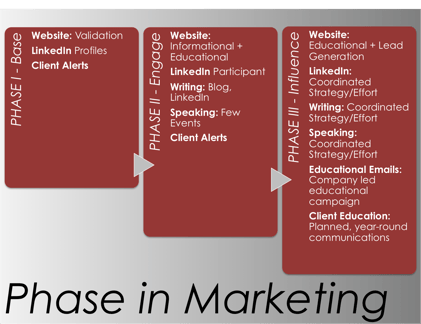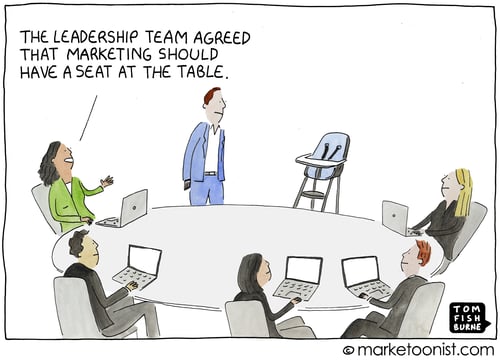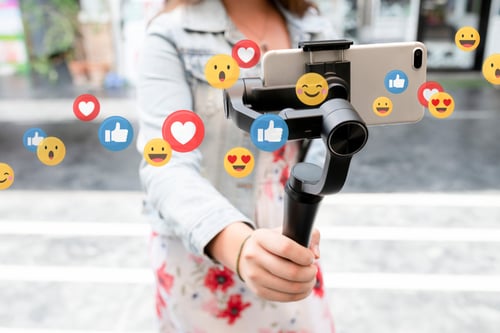This article is updated here and has been edited to include needed and updated information.
Like it or not, and believe it or not, marketing is the first step of the modern selling process. The first face-to-face meeting between buyer and sales person is so far down the buyer’s journey of researching options that waiting until that meeting to influence the buyer puts you in a very weak and reactionary position.
Begin educating buyers through marketing activities well before the sales meeting ever happens and your sales improve. It’s a pretty simple idea.
But to get marketing right is not so simple. Good marketing requires preparation and a lot of work before doing any activities, and quite frankly, that’s just not something agencies do very often or well.
However, if you take the time and put in the effort to get this right, you can DOMINATE your market, simply because most people won’t do it. They want to skip straight into the fun part of random activities without having a plan of what to do or why to do it. But that random activity will generate about the same results as not participating in marketing at all. So just save yourself the effort in that case.
Agencies consistently fail at marketing because they don’t start with Brand Definition, don’t pick activities strategically, and don’t stick to the plan.
For those of you not afraid of the hard work, start with these two steps:
- Read my first article on how to develop your insurance agency marketing platform: Improve Insurance Agency Marketing & Selling by First Defining Your Brand
- Read on below to see how to shape up and plan your marketing program with these 6 insurance marketing ideas – which is the work you do AFTER you’ve Defined Your Brand.
Agency Marketing Platform
There are so many different marketing activities you can pursue as a business. Our experience says that right now, these are the most important ways to spend your time building momentum for your insurance agency with these must-do marketing activities. As you read through the ideas below you’ll see that not only do we have the key suggested activities outlined, but we’ve even divided them into phases to help you organize your efforts.
PHASE I: Marketing Base
Every agency needs Phase I as the foundation of a marketing program, so start here and grow into other phases as needed. If you don’t get Phase I right, working on the others will be wasted effort.
MARKETING ACTIVITY #1
Client communications | Regularly send practical, useful tools and information to your clients to help them do their jobs better today. This is information you typically get from third party content providers with information about wellness, HR, compliance, etc.
MARKETING ACTIVITY #2
Website | Every agency needs a modern, mobile-friendly website with descriptive text based on your Brand Definition:
The purpose of the website should be to validate your message and let people get to know you a little bit – you as an organization and not simply the products you offer.
MARKETING ACTIVITY #3
LinkedIn | Everyone on your team should have a completely filled in LinkedIn profile with descriptive text based on your Brand Definition. Everyone should be connected with one another in your agency as well as connected to your Company Page, which is also written based on your Brand Definition ideas. This allows readers to see everyone who is a part of your company, the breadth of skills and talent on your team, and that you are a modern organization that recognizes the power of transparency and sharing online.
The goal of Phase I is to have basic-level communications with your key audiences – clients and prospects. These are minimum expectations that any employer should see from a broker. If you can’t get this organized, you shouldn’t expect anyone to think you’d be capable of more sophisticated communication efforts.
PHASE II: Engaging with Audience
In Phase II you move from being fairly passive with your communication to being more proactive. Here you make a commitment to carving out regular time for providing educational information to your audience and sharing your ideas and opinions across multiple mediums.
- Website | Step up your website commitment to being sharing ideas via a blog and collecting email addresses from prospects for regular mailing.
- LinkedIn | Step up your LinkedIn activity to become a participant by sharing ideas and liking/commenting on articles, updates, or groups.
MARKETING ACTIVITY #4
Writing | It’s time to get comfortable expressing your ideas and opinions publicly. If you’re not used to writing, then start easy by writing 2-3 sentences when sharing articles and ideas on LinkedIn updates. As you get comfortable with this you can work your way up to writing blog posts/articles.
MARKETING ACTIVITY #5
Speaking | This is also about being comfortable communicating your ideas in public. This can vary greatly from hosting seminars where you bring in an outside speaker (you do the introductions), to organizing round table discussions where you facilitate a conversation, to creating your own educational presentations where you’re the main show.
Phase II is great for individual producers within an agency to develop their own personal brand. It also works very well for single-producer agencies with limited resources who only need to write a handful of new accounts each year. This is also a good platform for engaging your whole team in marketing efforts.
PHASE III: Influencing Audience
This is the Phase where you go all in and make an organizational commitment to marketing. Here you’re moving from sharing information and engaging with your audience a little bit to influencing their behaviors through your more proactive and organized activities. Includes Phase I and II, plus:
- Step up all activities | Everything from Phase I and II should become part of an organized and coordinated company strategic effort, which includes content publishing and calls-to-action to influence reader behaviors.
MARKETING ACTIVITY #6
Educational Prospect Emails | We save regular prospect emails for the end because it’s a big commitment. You need to be comfortable expressing your ideas and opinions in public and have systems for creating content to share with your audience. Through these emails you want to share original content delivered to an opt-in list of prospective clients. If you’re not comfortable with your brand message, expressing opinions, and creating content, this will never work.
In Phase III, marketing becomes a fulltime commitment, and you need either a full-time marketing manager and/or an outside marketing firm to organize and manage your marketing program. You should also budget for an automated marketing platform to manage all of the work to be done, whether you are doing the work in-house or working with an outside marketing firm.
Put marketing into perspective to make your commitment
Effective marketing requires a long-term commitment. Honestly evaluate your resources and determine the people and financial investment you need and are willing to make. If you’re not going to devote time and money to marketing efforts, then choose Phase I and do it well. That’s just fine. If you start Phase II or III and don’t stick with the program, it’s going to do you more harm than good.
And you need to recognize and appreciate the role that marketing plays within the sales process. Marketing activities alone are not going to get you new business with the complex work that benefits consultants do. But the efforts will set your sales people up for more successful conversations when given the opportunity to meet face-to-face.
Finally, regardless of how much marketing you commit to doing, it does not preclude your sales team from prospecting. They still need to put a constant focus on filling the pipeline on a daily/weekly basis. That is why they get paid so well. Marketing is there to support and enhance their prospecting efforts.
- Marketing is for generating mid-to-long range pipeline activity. It’s great for developing brand and moving buyers toward you, but it takes time to build the momentum of having prospects calling you to set up appointments.
- Sales prospecting is for generating immediate pipeline activity. This includes asking for referrals from clients and centers of influence, cold calling/emails, and networking. Don’t use marketing as an excuse to NOT prospect.
Stop falling for “opportunities” and stick to your own program
There are hundreds of “opportunities” for you to pursue in marketing activities. There are also hundreds of ways for you to waste time and money with marketing activities. We’ve worked with and watched so many agencies start and stop various marketing efforts over the years and very few ever get it right.
To help you avoid that frustration and skip right to the “making progress” part of marketing, we’ve narrowed down those options for you here. Select the Phase that best matches your needs and get started today. Keep your head down and focus on these activities every day and you will start seeing buyers become more and more interested in what you have to say.
And make no mistake: Marketing is no longer optional. The days of depending on carriers (or simply product need) to create demand are over. ALL brokers must compete on the value they deliver, which means you need effective marketing to tell your new story and dispel the stereotype that is automatically dumped on you by the employers if you leave it up to them to make assumptions about who you are and what you do.
"No marketing, no meetings" will become more and more real for anyone competing to win the business of an employer looking to hire a consultant.
Photo by Mindy Johnson.








